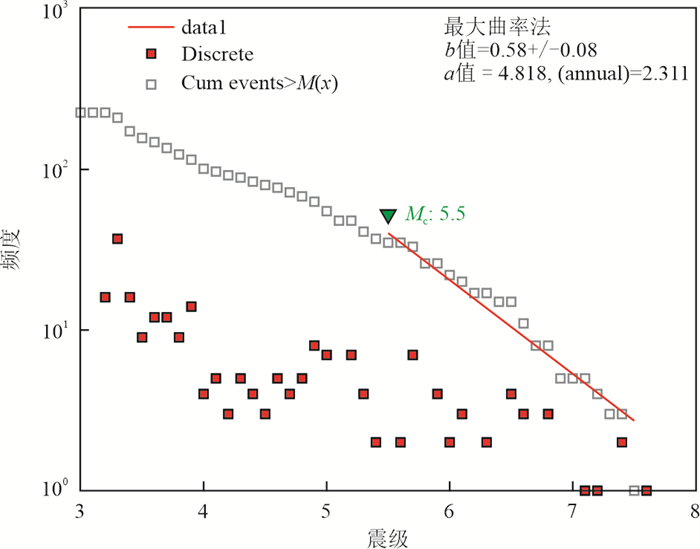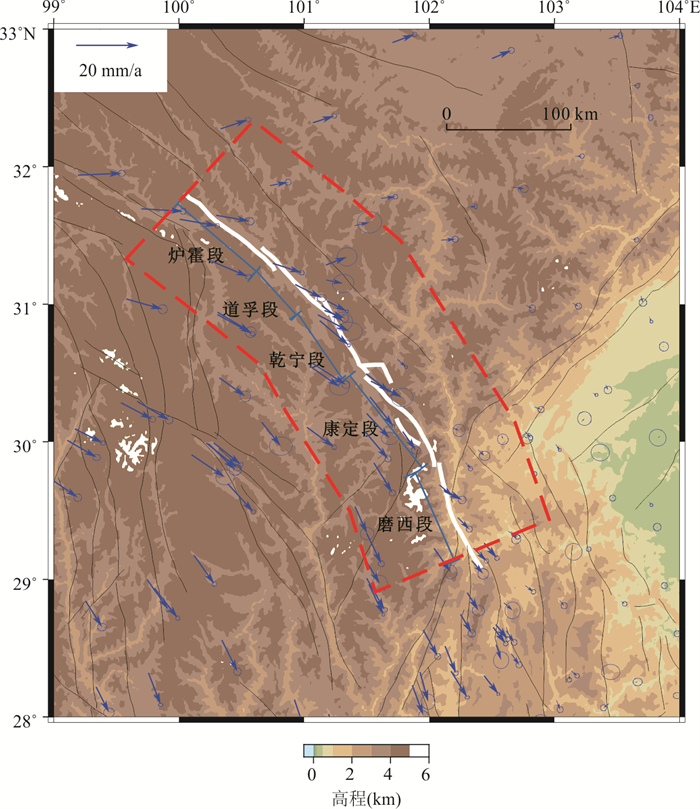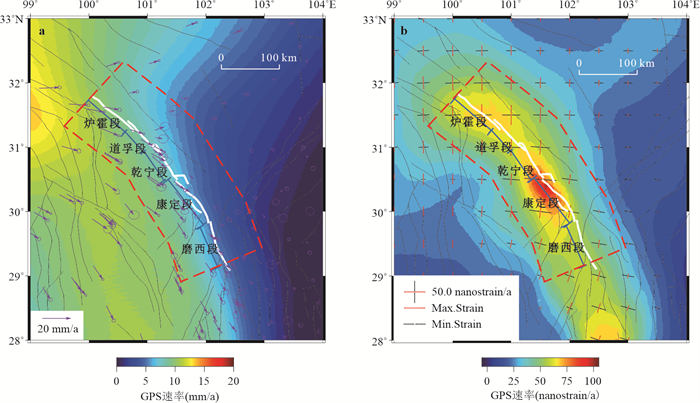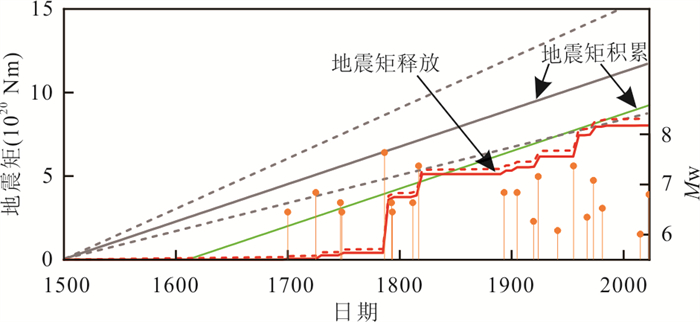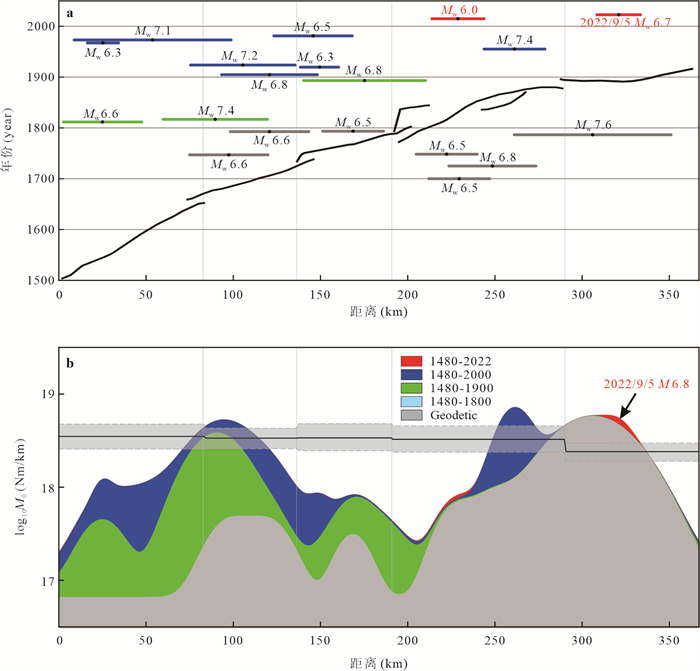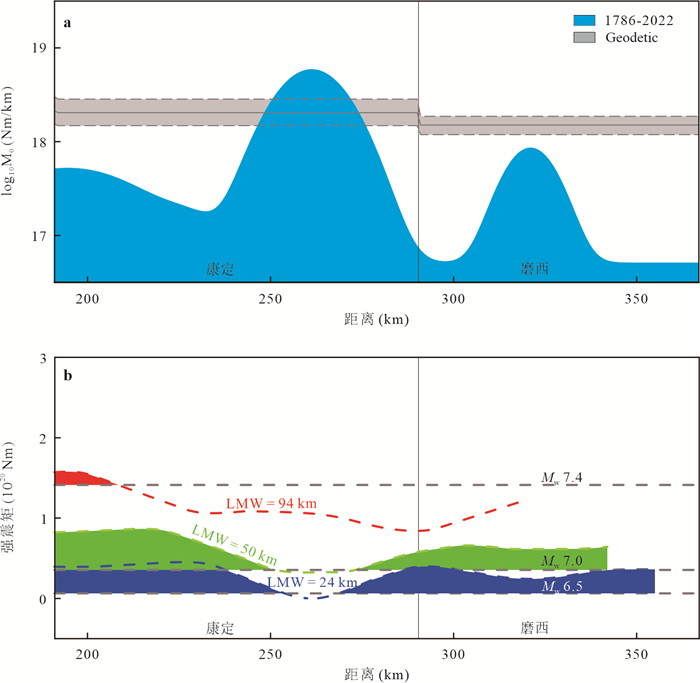Spatial Distribution of Seismic Moment Deficit in Xianshuihe Fault Zone and the 2022 Luding M 6.8 Earthquake
-
摘要: 2022年9月5日泸定M 6.8级地震发生在鲜水河断裂带南端的磨西断裂. 该地震的发震机制以及未来该断裂段是否仍会发生强震是值得关注的科学问题.拟从地震能量积累与释放的角度来解释该地震的发震原因以及鲜水河断裂带未来的发震潜力. 通过对比地震矩积累与释放的时空分布,发现地震大都发生在地震矩亏损的段落,并有填补地震矩亏损的趋势. 此外,鲜水河断裂带至今存在3个显著的地震矩亏损段,均具发生6.5级以上地震的潜力. 1786年康定M 7.6级地震发生之后,经过两百多年时间的积累,足以发生M 6.5级以上地震,而泸定M 6.8级地震仅释放了磨西断裂上部分的地震矩亏损,未来该断裂段仍具有发生强震的可能.
-
关键词:
- 地震矩亏损 /
- 鲜水河断裂带 /
- 泸定M 6.8级地震 /
- 地震危险性分析
Abstract: On September 5, 2022, an M6.8 earthquake located at the Moxi fault at the southern end of the Xianshuihe fault zone. The seismogenic mechanism of this earthquake and whether large earthquakes will occur in this fault section in the near future are scientific issues worth attention. This paper attempts to explain the seismogenic mechanism of the earthquake and the potential seismogenic potential of the Xianshuihe fault zone in the future from the perspective of the accumulation and release of seismic energy. By comparing the temporal and spatial distribution of seismic moment accumulation and release, it is found that earthquakes mostly occur in the period of seismic moment deficit, and there is a tendency to fill the moment deficit. In addition, there are three significant moment deficit segments in Xianshuihe fault zone. All of these moment deficit fault segments have the potential to produce earthquakes of magnitude 6.5 or greater. After the 1786 Kangding M 7.6 earthquake, the accumulation of 200 years is enough to produce an earthquake of M 6.5 or above. The Luding M 6.8 earthquake only released a small part of the moment deficit on the Moxi fault, and there is still a possibility of a major earthquake on this fault section in the future. -
图 2 鲜水河断裂带内地震记录的Gutenberg-Richter估计
由开源代码ZMAP绘制;Wiemer(2001);Mc为最小完备震级,红色方点为各震级的频度,灰色方点为累积的地震频度
Fig. 2. The Gutenberg-Richter distribution of seismic events in the Xianshuihe fault zone
图 3 GPS速度场(相对于稳定的华南块体)
数据来自Wang and Shen(2020). 红色虚线围限的多边形区域是拟分析的地震带.
Fig. 3. GPS velocity field (with respect to the stable south China block)
表 1 自1500年以来鲜水河断裂带上历史和仪器记录的大地震(M > 6.0)
Table 1. Large earthquakes (M > 6.0) of the historic and recorded seismic catalogs on the Xianshuihe fault
年份 经度(ºE) 纬度(ºN) 断层段 MS MW 破裂长度(1)
(km)M0
(1018 Nm)2022 102.08 29.59 磨西 6.80 6.700 25 12.60 2014 101.68 30.29 康定 6.30 6.000 30(2) 1.15 1981 101.15 30.95 道孚 6.90 6.520 45 6.85 1973 100.52 31.50 炉霍 7.60 7.100 90 46.77 1967 100.20 31.62 炉霍 6.80 6.350 18 3.71 1955 101.84 30.03 康定 7.50 7.370 35 127.35 1923 100.90 31.17 道孚 7.30 7.160 60 61.24 1919 101.07 31.00 道孚 6.25 6.300 22(3) 2.80 1904 101.00 31.06 道孚 7.00 6.840 55 20.42 1893 101.37 30.70 康定 7.00 6.840 70 20.42 1816 100.75 31.29 道孚 7.50 7.370 60 127.35 1811 100.15 31.61 炉霍 6.75 6.635 45 10.06 1793 101.33 30.75 乾宁 6.50 6.450 35 5.31 1792 101.00 31.06 乾宁 6.75 6.635 45 10.06 1786 102.04 29.87 康定 7.75 7.635 90 318.05 1748 101.62 30.33 康定 6.50 6.450 35 5.31 1747 100.85 31.23 道孚 6.75 6.635 45 10.06 1725 101.83 30.16 康定 7.00 6.840 50 20.42 1700 101.79 30.36 康定 6.50 6.450 35 5.31 注:(1) Wen et al.(2008) ; (2) 易桂喜等(2015); (3) 震级-破裂长度经验公式估计(Wells and Coppersmith, 1994).表 2 应变率及地震矩积累速率($ {\dot{\boldsymbol{M}}}^{\boldsymbol{G}} $)的计算
Table 2. Calculation of strain rate and moment accumulated rate ($ {\dot{\boldsymbol{M}}}^{\boldsymbol{G}} $)
区域 面积
(1010 m2)应变率(10-9/a) H
(103 m)μ
(1010 N/m2)$ {\dot{M}}^{G} $
(1017 Nm/a)鲜水河 5.57 $ 39.{3}_{-3.7}^{+5.6} $ 17 ±3 3 $ 22.{4}_{-5.7}^{+7.7} $ 注:H是断层带的深度;μ是断层的剪切模量;计算应变率场时Wt为18,Wt的不确定范围为±6. -
Allen, C. R., Luo, Z. L., Qian, H., et al., 1991. Field Study of a Highly Active Fault Zone: The Xianshuihe Fault of Southwestern China. Geological Society of America Bulletin, 103(9): 1178-1199. https://doi.org/10.1130/0016-7606(1991)103<1178:fsoaha>2.3.co;2 doi: 10.1130/0016-7606(1991)103<1178:fsoaha>2.3.co;2 Cheng, J., Rong, Y. F., Magistrale, H., et al., 2017. An Mw‐Based Historical Earthquake Catalog for Mainland China. Bulletin of the Seismological Society of America, 107(5): 2490-2500. https://doi.org/10.1785/0120170102 Chousianitis, K., Ganas, A., Evangelidis, C. P., 2015. Strain and Rotation Rate Patterns of Mainland Greece from Continuous GPS Data and Comparison between Seismic and Geodetic Moment Release. Journal of Geophysical Research: Solid Earth, 120(5): 3909-3931. https://doi.org/10.1002/2014jb011762 D'Agostino, N., 2014. Complete Seismic Release of Tectonic Strain and Earthquake Recurrence in the Apennines (Italy). Geophysical Research Letters, 41(4): 1155-1162. https://doi.org/10.1002/2014gl059230 Hanks, T. C., Kanamori, H., 1979. A Moment Magnitude Scale, Journal of Geophysical Research, 84(NB5): 2348-2350. https://doi.org/10.1029/JB084iB05p02348. Kostrov, B. V., 1974. Seismic Moment and Energy of Earthquakes, and Seismic Flow of Rock Izv. Acad. Sci. Ussr Phys. Solid Earth, 1: 23-44. Li, Y. X., Bürgmann, R., 2021. Partial Coupling and Earthquake Potential along the Xianshuihe Fault, China. Journal of Geophysical Research: Solid Earth, 126(7): 1-5. https://doi.org/10.1029/2020jb021406 Malservisi, R., Gans, C., Furlong, K. P., 2003. Numerical Modeling of Strike-Slip Creeping Faults and Implications for the Hayward Fault, California. Tectonophysics, 361(1/2): 121-137. https://doi.org/10.1016/s0040-1951(02)00587-5 Meade, B. J., 2002. Estimates of Seismic Potential in the Marmara Sea Region from Block Models of Secular Deformation Constrained by Global Positioning System Measurements. Bulletin of the Seismological Society of America, 92(1): 208-215. https://doi.org/10.1785/0120000837 Min, Z., Wu, G., Jiang, Z., et al., 1995. The Catalogue of Chinese Historical Strong Earthquakes (B. C. 2300-A. D. 1911). Seismological Publishing House, Beijing (in Chinese). Ojo, A. O., Kao, H., Jiang, Y., et al., 2021. Strain Accumulation and Release Rate in Canada: Implications for Long-Term Crustal Deformation and Earthquake Hazards. Journal of Geophysical Research: Solid Earth, 126(4): 1-16. https://doi.org/10.1029/2020jb020529 Qiao, X., Zhou, Y., 2021. Geodetic Imaging of Shallow Creep along the Xianshuihe Fault and its Frictional Properties. Earth and Planetary Science Letters, 567(2): 117001. https://doi.org/10.1016/j.epsl.2021.117001 Reid, H. F., 1910. The California Earthquake of April 18, 1906. Volume Ⅱ. The Mechanics of the Earthquake. Carnegie Institution of Washington, Washington, D. C. Shen, Z. K., Lü, J. N., Wang, M., et al., 2005. Contemporary Crustal Deformation around the Southeast Borderland of the Tibetan Plateau. Journal of Geophysical Research: Solid Earth, 110(B11): 5-20. https://doi.org/10.1029/2004jb003421 Shen, Z. K., Wang, M., Zeng, Y. H., et al., 2015. Optimal Interpolation of Spatially Discretized Geodetic Data. Bulletin of the Seismological Society of America, 105(4): 2117-2127. https://doi.org/10.1785/0120140247 Sparacino, F., Palano, M., Peláez, J. A., et al., 2020. Geodetic Deformation Versus Seismic Crustal Moment-Rates: Insights from the Ibero-Maghrebian Region. Remote Sensing, 12(6): 952. https://doi.org/10.3390/rs12060952 Tape, C., Musé, P., Simons, M., et al., 2009. Multiscale Estimation of GPS Velocity Fields. Geophysical Journal International, 179(2): 945-971. https://doi.org/10.1111/j.1365-246x.2009.04337.x Tapponnier, P., Xu, Z. Q., Roger, F., et al., 2001. Oblique Stepwise Rise and Growth of the Tibet Plateau. Science, 294(5547): 1671-1677. https://doi.org/10.1126/science.105978 Wang, S., Wu, G., Shi, Z., 1999. The Catalogue of Recent Earthquakes in China (A. D. 1912-A. D. 1990), China Science and Technology Publishing House, Beijing, China (in Chinese). Wang, H., Liu, M., Cao, J. L., et al., 2011. Slip Rates and Seismic Moment Deficits on Major Active Faults in Mainland China. Journal of Geophysical Research, 116(B2): 255-263. https://doi.org/10.1029/2010jb007821 Wang, H., Liu, M., Shen, X. H., et al., 2010. Balance of Seismic Moment in the Songpan-Ganze Region, Eastern Tibet: Implications for the 2008 Great Wenchuan Earthquake. Tectonophysics, 491(1/2/3/4): 154-164. https://doi.org/10.1016/j.tecto.2009.09.022 Wang, M., Shen, Z. K., 2020. Present‐Day Crustal Deformation of Continental China Derived from GPS and its Tectonic Implications. Journal of Geophysical Research: Solid Earth, 125(2): 125-139. https://doi.org/10.1029/2019jb018774 Wang, W., Qiao, X. J., Yang, S. M., et al., 2017. Present-Day Velocity Field and Block Kinematics of Tibetan Plateau from GPS Measurements. Geophysical Journal International, 208(2): 1088-1102. https://doi.org/10.1093/gji/ggw445 Ward, S. N., 1998. On the Consistency of Earthquake Moment Rates, Geological Fault Data, and Space Geodetic Strain: The United States. Geophysical Journal International, 134(1): 172-186. https://doi.org/10.1046/j.1365-246x.1998.00556.x Wells, D. L., Coppersmith, K. J., 1994. New Empirical Relationships among Magnitude, Rupture Length, Rupture Width, Rupture Area, and Surface Displacement. Bulletin of the Seismological Society of America, 84(4): 974-1002. https://doi.org/10.1785/bssa0840040974 Wen, X. Z., Ma, S. L., Xu, X. W., et al., 2008. Historical Pattern and Behavior of Earthquake Ruptures along the Eastern Boundary of the Sichuan-Yunnan Faulted-Block, Southwestern China. Physics of the Earth and Planetary Interiors, 168(1/2): 16-36. https://doi.org/10.1016/j.pepi.2008.04.013 Wesson, R. L., 1988. Dynamics of Fault Creep. J. Geophys. Res. , 93(B8): 8929-8951, https://doi. org/https://doi.org/10.1029/JB093iB08p08929. Wiemer, S., 2001. A Software Package to Analyze Seismicity: ZMAP. Seismological Research Letters, 72(3): 373-382. https://doi.org/10.1785/gssrl.72.3.373 Xu, X. W., Wen, X. Z., Zheng, R. Z., et al., 2003. Pattern of Latest Tectonic Motion and its Dynamics for Active Blocks in Sichuan-Yunnan Region, China. Science in China Series D Earth Sciences, 46(S2): 210-226(in Chinese with English abstract). doi: 10.1360/03dz0017 Yi, G., Long, F., Wen, X., et al., 2015. Seismogenic Structure of the M 6.3 Kangding Earthquake Sequence on 22 Nov. 2014, Southwestern China, Chinese Journal of Geophysics-Chinese Edition, 58(4): 1205-1219 (in Chinese with English abstract). Zhang, P. Z., 2013. A Review on Active Tectonics and Deep Crustal Processes of the Western Sichuan Region, Eastern Margin of the Tibetan Plateau. Tectonophysics, 584(B2): 7-22. https://doi.org/10.1016/j.tecto.2012.02.021 Zhao, G. Q., Meng, G. J., Wu, W. W., et al., 2021. Earthquake Potential Assessment around the Southeastern Tibetan Plateau Based on Seismic and Geodetic Data. Pure and Applied Geophysics, 179(1): 11-44. https://doi.org/10.1007/s00024-021-02917-6 闵子群, 吴戈, 江在雄, 等, 1995. 中国历史地震目录(公元前23世纪—公元1911年). 北京: 地震出版社. 汪素云, 吴戈, 时振梁, 等, 1999. 中国近代地震目录(公元1912—1990). 北京: 中国科学技术出版社. 徐锡伟, 闻学泽, 郑荣章, 等, 2003. 川滇地区活动块体最新构造变动样式及其动力来源. 中国科学(D辑), 46: 210-226. 易桂喜, 龙锋, 闻学泽, 等, 2015. 2014年11月22日康定M6.3级地震序列发震构造分析. 地球物理学报, 58(4): 1205-1219. https://www.cnki.com.cn/Article/CJFDTOTAL-DQWX201504010.htm -
 dqkxzx-49-2-425-附图.jpg
dqkxzx-49-2-425-附图.jpg

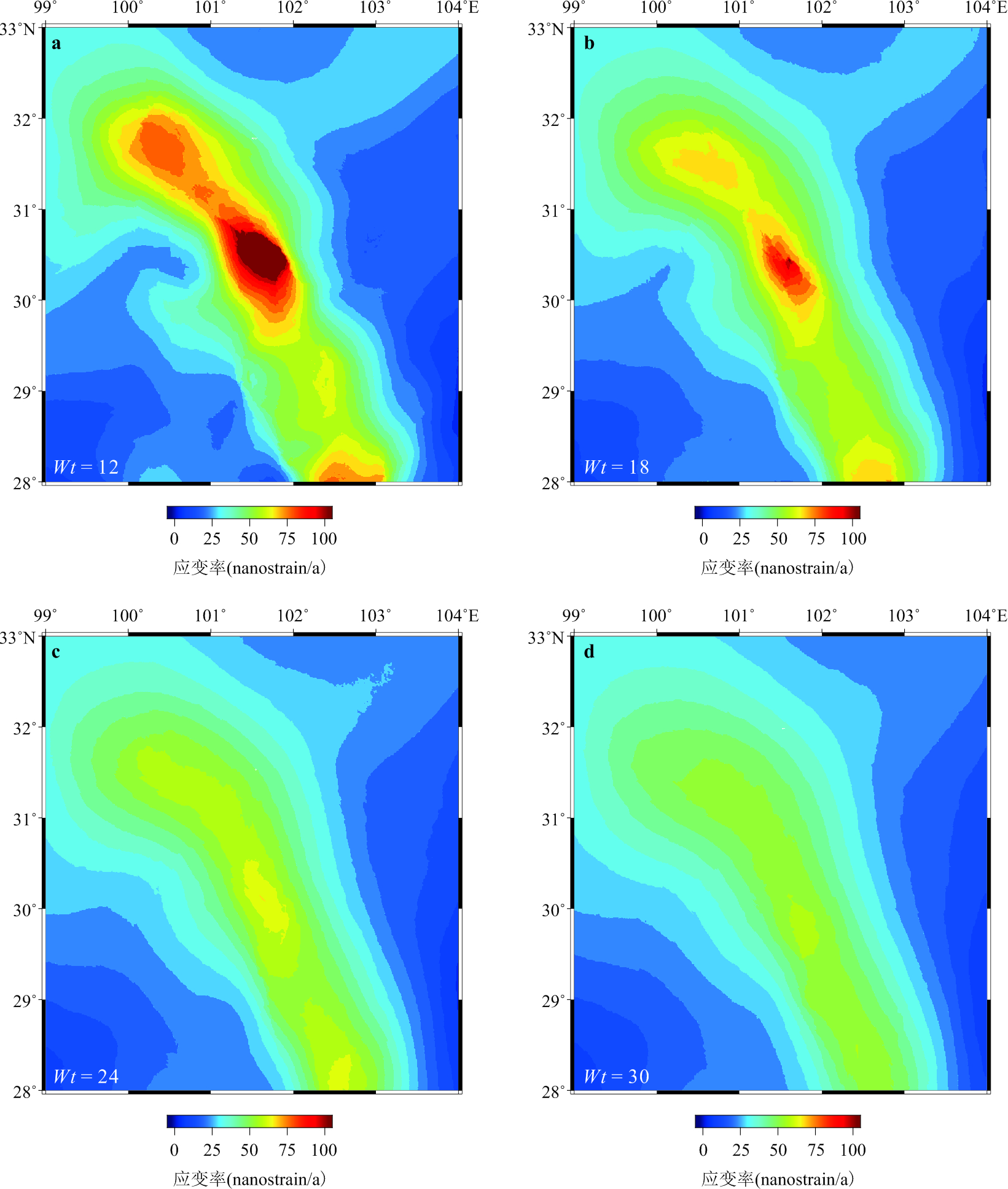
-









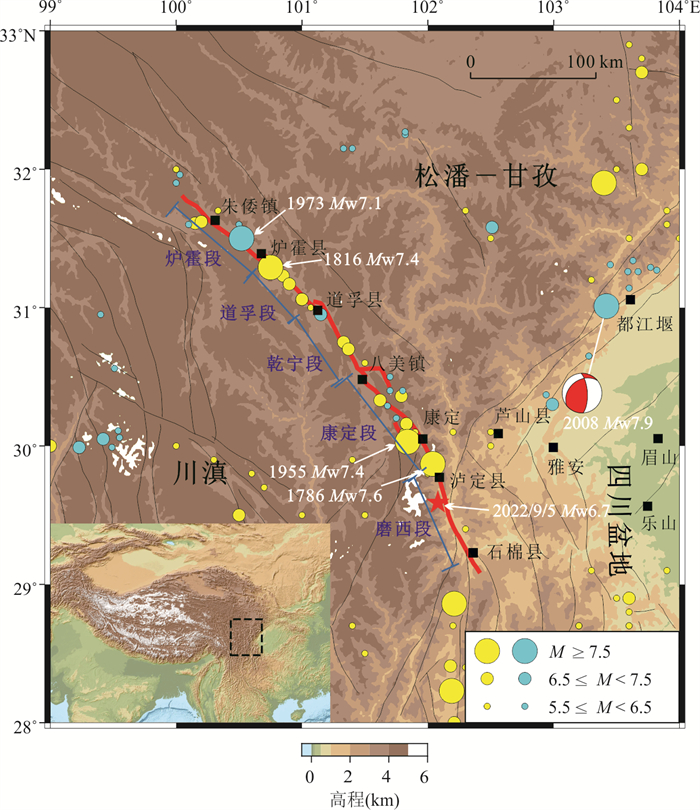
 下载:
下载:
